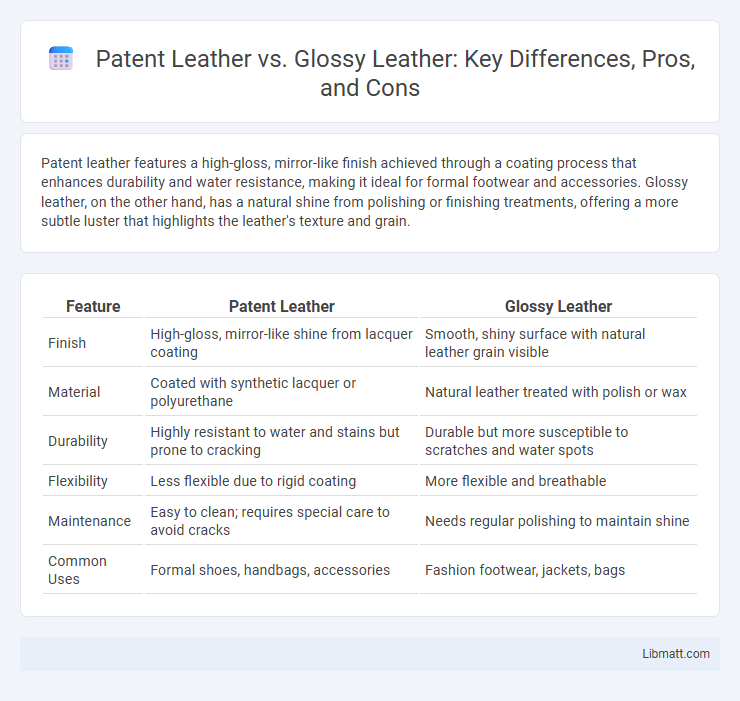Patent leather features a high-gloss, mirror-like finish achieved through a coating process that enhances durability and water resistance, making it ideal for formal footwear and accessories. Glossy leather, on the other hand, has a natural shine from polishing or finishing treatments, offering a more subtle luster that highlights the leather's texture and grain.
Table of Comparison
| Feature | Patent Leather | Glossy Leather |
|---|---|---|
| Finish | High-gloss, mirror-like shine from lacquer coating | Smooth, shiny surface with natural leather grain visible |
| Material | Coated with synthetic lacquer or polyurethane | Natural leather treated with polish or wax |
| Durability | Highly resistant to water and stains but prone to cracking | Durable but more susceptible to scratches and water spots |
| Flexibility | Less flexible due to rigid coating | More flexible and breathable |
| Maintenance | Easy to clean; requires special care to avoid cracks | Needs regular polishing to maintain shine |
| Common Uses | Formal shoes, handbags, accessories | Fashion footwear, jackets, bags |
Introduction to Patent Leather and Glossy Leather
Patent leather features a high-gloss finish achieved through a coating process that seals the leather, providing a shiny, reflective surface ideal for formal footwear and accessories. Glossy leather, often treated with special polishes or finishes rather than coatings, offers a sleek, smooth appearance with more natural texture visibility compared to patent leather's mirror-like shine. Both types emphasize aesthetic appeal but differ in production techniques, durability, and maintenance requirements.
Definition and Key Characteristics
Patent leather is a type of coated leather with a high-gloss, shiny finish achieved through a plastic or lacquer layer, making it smooth and reflective. Glossy leather refers broadly to leather treated or polished to have a lustrous surface, often maintaining more natural texture beneath the shine. Patent leather is typically stiffer and less breathable than glossy leather, which can vary in flexibility and is known for a subtler, elegant sheen.
Manufacturing Processes Compared
Patent leather undergoes a meticulous coating process involving a layer of lacquer or plastic that creates its signature high-gloss, glass-like finish, providing water resistance and a smooth surface. Glossy leather, on the other hand, achieves shine primarily through buffing and polishing treatments without a thick coating, preserving more of the leather's natural texture and breathability. Understanding these manufacturing processes helps you choose the best option based on desired durability, appearance, and comfort.
Appearance and Texture Differences
Patent leather features a highly reflective, mirror-like finish achieved through a coating process that gives it a smooth, almost plastic texture. Glossy leather, while also shiny, maintains more of the natural grain and softness of the leather, resulting in a sleek but more tactile surface. Your choice between the two affects both the visual impact and the feel of the material, with patent leather offering a bold, polished look and glossy leather providing a subtle, sophisticated shine.
Durability and Maintenance
Patent leather offers high durability due to its thick, lacquered finish, which resists water and stains better than glossy leather. Glossy leather, while visually shiny, is more susceptible to scratches and requires careful conditioning to maintain its appearance. Proper maintenance of patent leather involves simple cleaning with a damp cloth, whereas glossy leather demands regular polishing and protection from moisture to preserve its shine and longevity.
Common Uses in Fashion and Accessories
Patent leather is frequently used in formal footwear, handbags, and belts due to its high-gloss finish that adds a polished, sophisticated look to evening wear and special occasion attire. Glossy leather, often achieved through waxing or polishing, appears in jackets, gloves, and casual shoes, offering a sleek yet versatile style suitable for both everyday and semi-formal fashion. Both materials enhance accessories by providing durable surfaces with varying degrees of shine, catering to distinct aesthetic preferences in the fashion industry.
Price and Value Comparison
Patent leather typically commands a higher price due to its specialized coating and glossy finish, which requires more intricate manufacturing processes. Glossy leather, often achieved through polishing or finishing treatments on regular leather, tends to be more affordable but may lack the durability and water resistance of patent leather. The value of patent leather lies in its distinctive shine and longevity, making it a preferred choice for formal footwear and accessories despite the higher cost.
Environmental Impact and Sustainability
Patent leather, coated with a thick layer of plastic or synthetic resin, often relies on non-biodegradable materials that contribute to environmental pollution and present recycling challenges. Glossy leather, typically finished with natural oils and waxes, tends to have a lower environmental footprint due to more sustainable production methods and better biodegradability. Choosing glossy leather over patent options supports reduced synthetic waste and promotes eco-friendly leather processing.
Popular Brands and Products
Popular brands like Christian Louboutin and Gucci often feature patent leather in their iconic footwear collections, prized for its mirror-like shine and sleek appearance. Glossy leather, commonly seen in Coach and Clarks products, offers a subtler sheen and durable finish perfect for everyday wear. Your choice between patent and glossy leather hinges on the desired look and product use, with luxury brands emphasizing patent leather's high-gloss elegance and others opting for the versatility of glossy leather.
Choosing Between Patent Leather and Glossy Leather
Patent leather features a high-gloss, mirror-like finish achieved through a coating process, offering exceptional shine and durability ideal for formal footwear and accessories. Glossy leather provides a polished surface with a subtler sheen, maintained through specialized finishing techniques that enhance its natural texture and flexibility. Choosing between patent and glossy leather depends on the desired level of luster, maintenance preference, and the intended occasion or style statement.
Patent leather vs glossy leather Infographic

 libmatt.com
libmatt.com